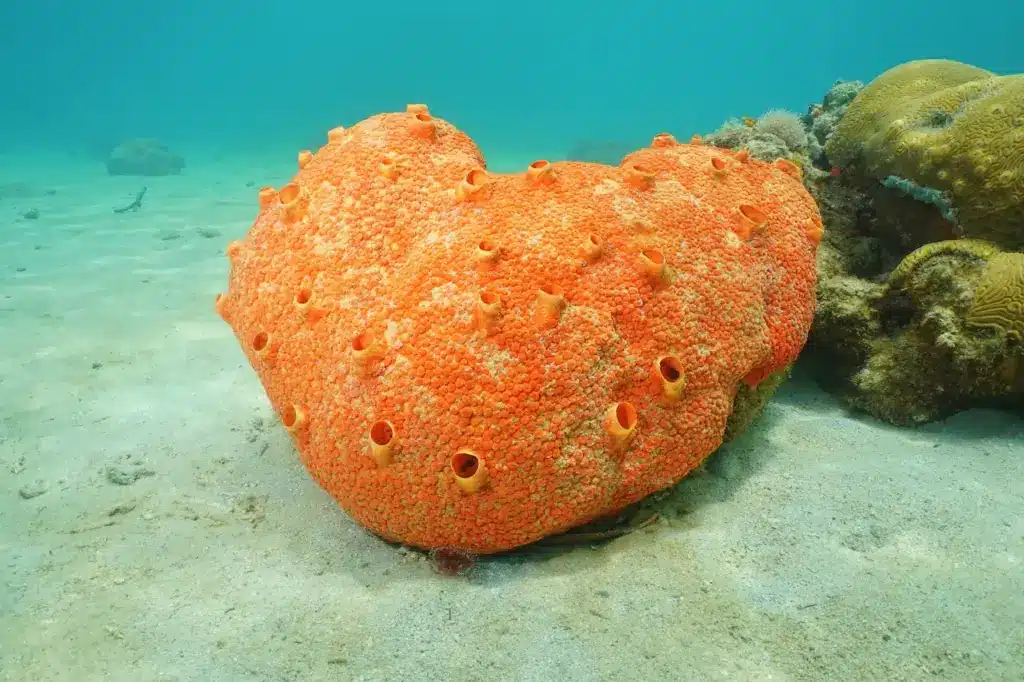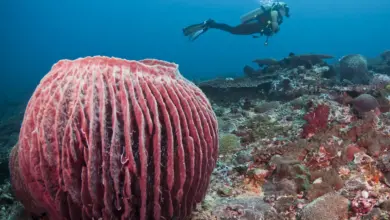Can Sponges Move?
Can Sponges Move Or Not?
Of course sponges can’t move. They’re sessile. Stuck to the seabed. Right?
Wrong.
Yes, it is true that sponges, in their adult form, remain mostly sedentary, the same cannot be said for sponge larvae.

Movement in Larval Sponges
First and foremost, sponge larvae are always ciliated. This is a big insight into the active world of sponge larvae.
Cilia are hair-like extensions protruding from main body of the larvae. The microscopic hairs beat against the water and propel the larval forward.
There are two distinct types of sponge larvae:
- Solid parenchymella larvae
- Hollow amphiblastula larvae
Let’s explore a little more.
Solid Parenchymella Larvae
Similar to cnidarian (jellyfish etc) larvae, solid parenchymella larvae lack internal cavities and are covered in flagellated cells over the entirety of their body.
The flagella aid in the free swimming phase of sponge development and play an important role in finding a suitable substrate to settle upon.
Sponge species whose larva are parenchymella include the majority of species in the class Demospongiae (scholarsbank.edu).
Depending on the species, some parenchymella larvae can be quite complex organisms.
Hollow Amphiblastula Larvae
Amphiblastula larvae, as the name may suggest, are a hollow blastulae (sphere of cells produced during the development of an embryo).
One half of the blastulae larvae is covered in small, flagellated cells. The other half comprises of large, non-flagellated macromeres, or blastomeres (a type of cell produced by cell division of the zygote after fertilisation) (zoology.edu).
Amphiblastula larvae are typically simple structures.
Both types of larvae spend typically no more than 3 days in larval form. The sponge larvae use ciliated and flagellated cells to help the organism enter the settlement, or creeping, stage, where they develop into sessile adults and lose the ability to move.
Or do they?
Do Sponges Exhibit Other Types of Movement?
You may have also picked up on that word “mostly” in the introduction.
This is because novel research, posted in Current Biology, may suggest that certain species of sponges can in fact move.
No, they don’t just pick themselves up and walk to a new spot.
As comical as that would be to picture, would-be sessile sponges take a new approach.
In the deep arctics, at depths of up to 1000 meters, a bustling cosmopolitan of sponge communities have been found. Around these communities, trails of spicules snaked between rocks, crevice’s and other sponges.
But what are spicules?
Spicules are the building blocks of the sponge. They are comprised of skeletal fragments made of calcium carbonate or silica. Spicules can be large enough to be seen by the naked eye, or only visible under the microscope (sjsu.edu).
According to scientists, the deep-sea trail of spicules were found connecting many different sponges.
The scientists were baffled.
Gravity was rules out; many sponges were found living on the uphill slopes of seamounts.
Strong undercurrents were also ruled out, as the site lacked any evidence of strong flows.
Instead, the team of scientists speculated that the sponges purposefully sank fragments of spicules into the ground and pull on them to creep forward. As the invertebrate inches forward, a trail of skeletal fragments and fleshy body parts remain behind.
Sounds like a nightmarish horror story, but the reality is rather quite clever. This just goes to show that being a simple, primitive organism may not be as bad as it sounds.
Sponges are able to regenerate from fragments, as a form of asexual reproduction. The wake of spicules and fleshy bits have the potential to regenerate into a clone sponge of the parent.
But why would a sponge need to crawl around in the first place?
Again, this is all speculation on the scientists’ behalf, but the team of researchers believe it is a way of searching for food.
At the very depths of the polar seas, food, and therefore nutrients, are hard to come by. It appears that sponges may seek drastic, alternative measures to find food (science.org).
Conclusion
There are two distinct types of sponge larvae – solid parenchymella larvae and hollow amphiblastula larvae – both with the capability to move to find suitable growing substrates to spend their adult lives.
Contrary to belief, sponge larvae may not be the only stage at which a sponge can move.
Aided by spicule fragmentation, deep-sea arctic sponges can move to find new feeding grounds and develop identical clones.

